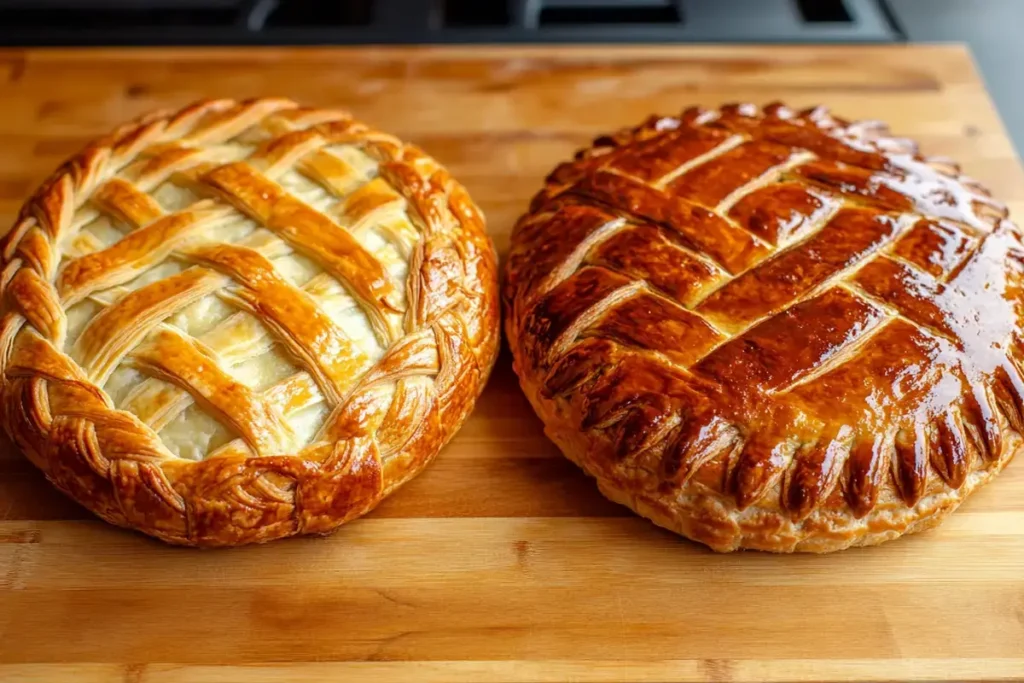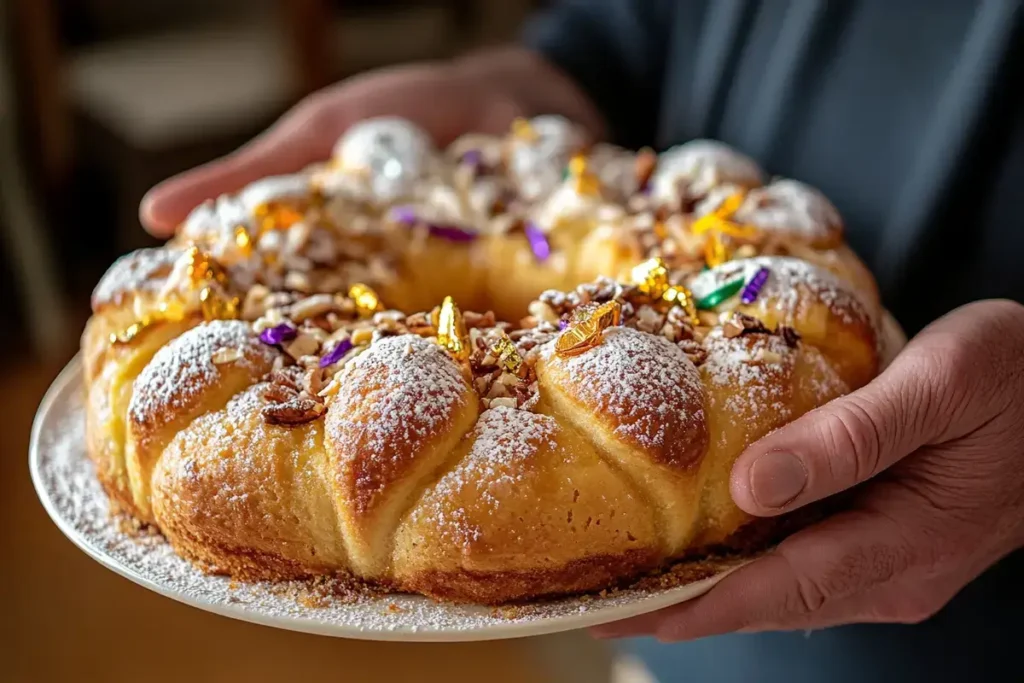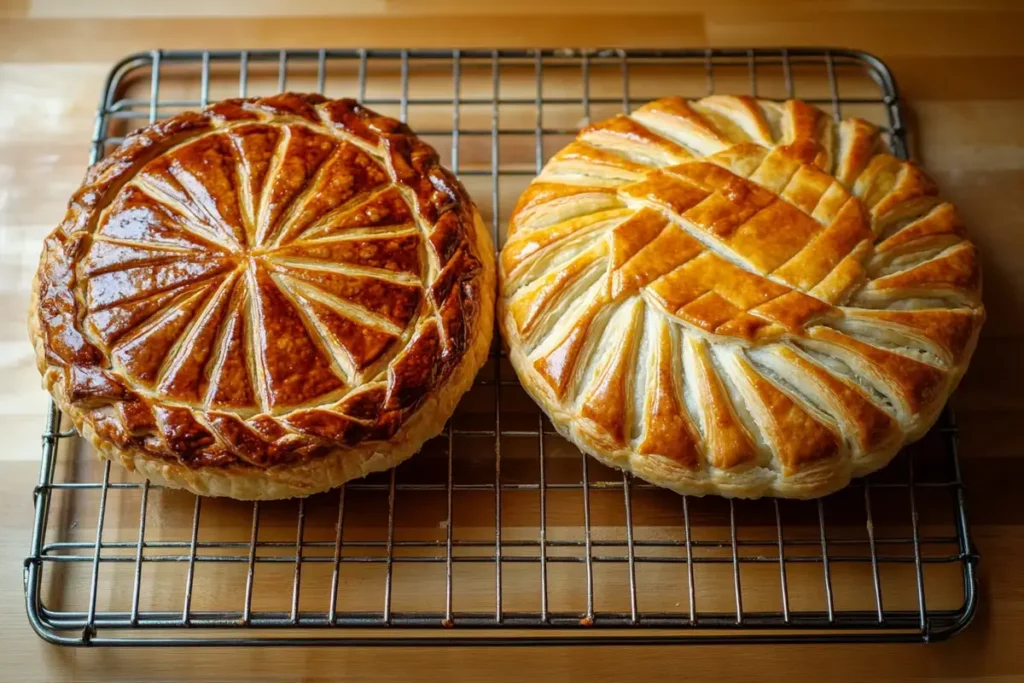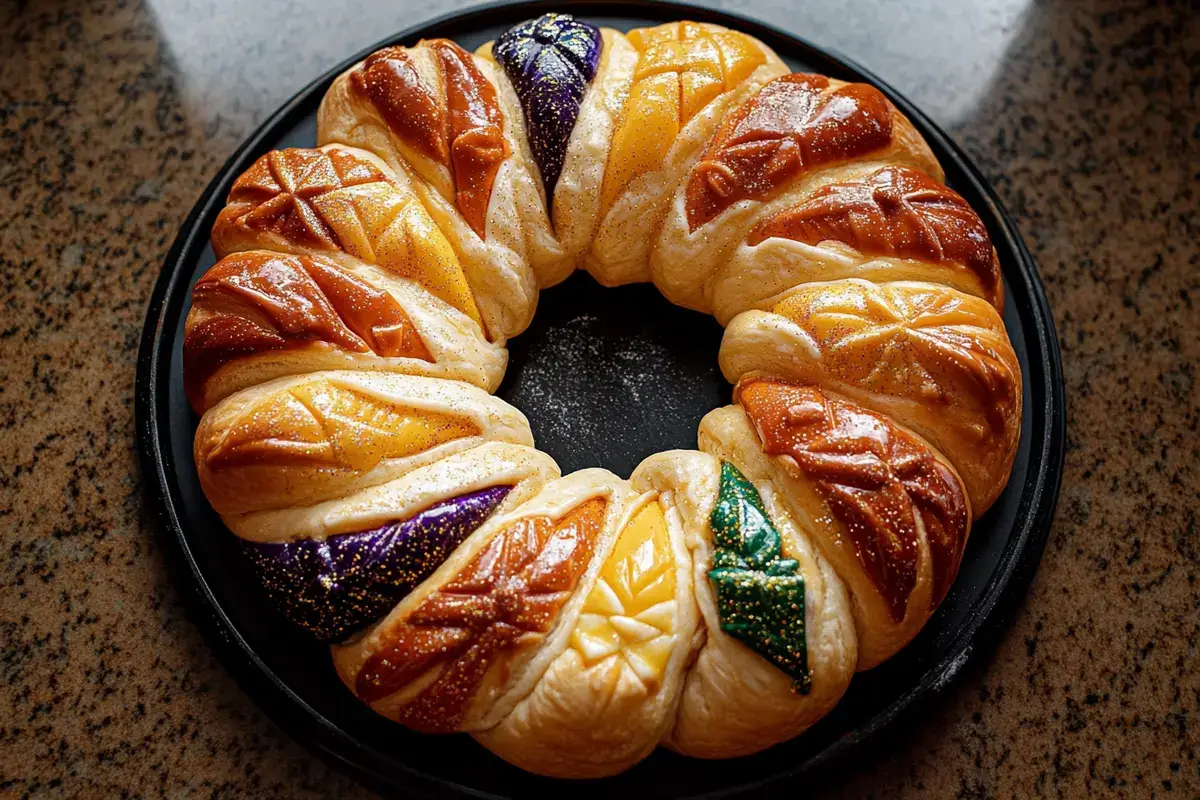What’s the difference between French and American king cake? This question captivates pastry lovers around the globe. Both versions of king cake bring joy during festive seasons. Yet, the contrasts in taste, tradition, and appearance are remarkable. In this Amazing Ultimate guide, we will explore each variety’s unique story. We will also discuss how they became cultural treasures.
Below, you will find an in-depth look at the origins, ingredients, flavors, and customs associated with both cakes. By the end, you will appreciate why the French king cake and the American king cake each hold a special place in the hearts of those who bake, eat, and celebrate with them.
Introduction of The Ultimate Guide
Understanding how these two king cakes diverge begins with their histories. French pastries have a long tradition of elegance and precision. American adaptations, particularly in Louisiana, blend multicultural influences. This guide will take you on a journey from medieval European courts to modern Mardi Gras parades. You will see how a single dessert can transform across oceans and centuries.
Historical Origins
King cakes trace back to the medieval celebration of Epiphany, a Christian feast day. In France, the day is known as La Fête des Rois. French bakers historically created a flaky, round pastry filled with almond cream. They called it the Galette des Rois. It was served on or around January 6.
Meanwhile, the American version, especially in Louisiana, blossomed from French colonial traditions. When French settlers arrived in New Orleans, they brought along their festive pastries. Over time, these pastries merged with local customs. The result was a ring-shaped, brioche-like cake brightly decorated with sugar and icing. Thus, American king cake emerged as a vibrant expression of regional culture.
Both share a symbolic baby figure hidden inside. Yet, the reason behind the baby can vary. In France, the trinket might be a bean or a ceramic figure, honoring the person who finds it as “king” or “queen” for the day. In America, it is often a small plastic baby representing luck or the start of next year’s party preparations.
Dough and Texture
The French king cake, or Galette des Rois, is typically a laminated puff pastry. It is buttery, flaky, and delicate. When you take a bite, you encounter crisp, layered dough. The slight crunch contrasts with the smooth almond cream filling, also known as frangipane. This refined pastry is often served warm, emphasizing its luxurious taste.
The American king cake, in contrast, is usually a brioche-based dough. It has a light, bread-like consistency. Often, it is twisted into an oval or circular shape. The texture is airy, with a gentle chewiness. Some bakers might opt for cinnamon-swirled dough. Others fill it with cream cheese or fruit compote for an extra burst of flavor. This variety is more akin to a festive sweet bread than a traditional puff pastry.
Flavor Profiles
French king cake is subtly sweet and rich. Its almond filling lends a nutty, aromatic depth. Mild sweetness allows the pastry’s buttery layers to shine. You might taste hints of vanilla or rum flavoring, though these are optional. Overall, the French version aims for a sophisticated balance of flavors.
On the American side, king cake can be quite sweet. Bakers drizzle thick icing on top, often in colors representing Mardi Gras: purple, green, and gold. Each color has its significance (justice, faith, and power). The sugary icing may contrast with a cinnamon-spiced dough. Alternatively, there may be fruit fillings like strawberry, apple, or blueberry. Cream cheese filling is also popular. Each baker might tweak the recipe, leading to new, fun flavors every year.
Cultural Significance
In France, the galette tradition is typically centered around Epiphany. Families and friends gather to cut the cake, searching for the hidden charm or “fève.” Whoever finds it wears a paper crown. Despite modernization, the ceremony is relatively subdued. It is common in homes, bakeries, and offices during the first weeks of January.
Across the Atlantic, American king cake is intertwined with Mardi Gras festivities. The carnival season starts on Twelfth Night (January 6) and leads up to Fat Tuesday. In New Orleans, king cakes are a staple at parties and parades. People indulge in them for weeks, sometimes turning the tradition into a full-blown celebration. The excitement of finding the plastic baby translates into hosting the next gathering or supplying the next king cake.

Symbolism and Ritual
Both cakes commemorate the Three Wise Men’s visit to baby Jesus. The “king” in king cake refers to Christ, recognized by Magi as King. The hidden bean or baby figure underscores the theme of revelation. In France, the one who finds the fève is named king or queen of the party. This crowning moment fosters community and fun.
In America, the baby figure typically symbolizes prosperity. The person who discovers it in their slice may be responsible for buying next year’s cake. Or they might host the next party. This friendly obligation keeps the tradition alive year after year. It builds bonds among families, friends, and entire communities.
Seasonal Celebrations
Epiphany is the main date for French king cake. Although some continue enjoying galette throughout January, it rarely extends beyond that month. In contrast, Mardi Gras season in Louisiana stretches from January 6 up to the Tuesday before Ash Wednesday. That entire period, known as Carnival, is filled with parties, parades, and endless king cake gatherings.
During these weeks, local bakeries in New Orleans might sell thousands of cakes. Offices, schools, and clubs often hold repeated celebrations. Meanwhile, those who prefer tradition might stick to plain cinnamon flavors. Adventurous eaters might try everything from praline pecan fillings to banana foster-inspired varieties. Regardless of preference, the continuous cycle of festivities makes the American king cake a social centerpiece.
Decorative Approach
The French galette is usually golden and glossy. The baker might carve patterns on top for decoration. Sometimes a dusting of powdered sugar or subtle slivers of almond is added. Presentation is elegant but not gaudy.
By contrast, the American king cake is a colorful spectacle. Purple, green, and gold sugars adorn the top in bold stripes or swirl patterns. Icing drips along the ring’s edges, creating a playful, eye-catching look. In many households, the more vibrant the decoration, the better. Some families get creative with edible glitter or unique shapes, emphasizing the joyful Mardi Gras spirit.
Taste Comparison: Sophistication vs. Festivity
If you bite into a French king cake, you might describe the experience as indulgent and refined. The layers of puff pastry yield a luxurious mouthfeel, while the almond cream provides a creamy contrast. It is less about overwhelming sweetness and more about a nuanced flavor journey.
When you sample an American king cake, you are likely to notice sugary icing first. Then you will appreciate a softer, bread-like consistency. Finally, you may find a sweet filling, from cream cheese to pecan praline. It is a more casual dessert, often enjoyed with a party atmosphere in mind. Some prefer that extra sweetness for a celebratory occasion.
Serving Suggestions
In France, a slice of galette des rois pairs beautifully with coffee or tea. Since the pastry is comparatively light, it can function as a delightful afternoon treat or a post-dinner dessert. Families often serve it warm to highlight its buttery flakiness.
Americans tend to serve king cake in large portions at gatherings. It might appear alongside cocktails, beer, or sodas during Mardi Gras festivities. People often slice big pieces, drizzle on additional icing, or fill them with whipped cream. The party spirit dictates that more is more!

Nutritional Aspects
The French galette is rich in butter and almond cream. Although it is not a light dessert, its portion size can be moderate. Because of its delicate layers, one small slice can be satisfying. Most recipes do not include heavy frosting. The result is fewer added sugars compared to some American versions.
Conversely, American king cake can be higher in sugar due to the icing and colorful sprinkles. Fillings like cream cheese or fruit compotes add extra sweetness. Also, the brioche dough often uses more sugar than a standard bread recipe. While it is undeniably delicious, mindful eaters might watch their slice size. Yet, during a carnival celebration, many enjoy it guilt-free, as part of the seasonal indulgence.
Regional Variations in America
Although New Orleans popularized the American king cake, other regions have their twists. In Texas, you might find a similarly ring-shaped pastry with sweeter dough. Some Texan bakeries incorporate local flavors like pecans or jalapeños for a sweet-and-spicy contrast. Meanwhile, parts of Mississippi or Alabama may focus on tangy fruit fillings. Cultural exchange has led to broad experimentation, showcasing the endless creativity behind the American king cake.
Modern Twists and Flavors
In France, modern pastry chefs occasionally spice up the traditional galette. You might see chocolate-infused frangipane or pistachio cream variations. Some even top their galettes with fresh fruit for a contemporary flair. Nevertheless, the overall style remains fairly classic: puff pastry plus a sophisticated filling.
The American approach is more adventurous. Popular local bakeries offer dozens of flavors each Carnival season. Past examples include bananas foster, praline, strawberry cream, cookie dough, and s’mores-inspired fillings. Social media has fueled the hype, as pictures of rainbow-colored or unusual king cakes go viral. Ultimately, the American king cake thrives on innovation, bridging tradition and novelty.
Serving Rituals and Gatherings
In French households, the galette is often cut by the youngest family member. That child sits under the table and calls out who gets each slice. It is a charming way to ensure the person distributing portions does not intentionally favor someone. The tradition fosters inclusivity, reminding everyone that we share in the joy.
In American communities, especially in New Orleans, the king cake might be served at an office party or a neighborhood gathering. When the plastic baby is discovered, the laughter and excitement peak. The lucky finder often exclaims, “I got the baby!” Everyone jokes about who will host next time or supply the next dessert. This playful atmosphere defines many Mardi Gras events, turning something as simple as slicing a cake into a communal adventure.
Why Both Cakes Matter?
Although they share the name “king cake,” these pastries symbolize distinct cultural expressions. The French version honors a centuries-old monarchy tradition, refined and elegant. The American version captures the spirit of a vibrant, diverse celebration like Mardi Gras. Each stands on its own as a testament to how food travels, adapts, and influences society.
A Side-by-Side Overview
To summarize, consider these key differences:
- Texture: French = flaky puff pastry with almond cream; American = soft, brioche-like dough often with icing and fillings.
- Sweetness: French = subtle sweetness; American = generally sweeter, often topped with frosting and colored sugar.
- Occasion: French = Epiphany (January 6); American = Mardi Gras season (January 6 to Fat Tuesday).
- Symbolism: Both contain a hidden charm. French uses a fève or ceramic figure; American often uses a plastic baby.
- Decorations: French = minimal, with classic pastry patterns; American = bold, colorful icing in purple, green, and gold.
Enjoying the Best of Both Worlds:
Many people wonder which version is “better.” The answer depends on personal taste. If you admire the finesse of French patisserie, you may prefer the understated elegance of galette des rois. If you love parties, vibrant icing, and sweet fillings, the American king cake might win your heart.
Why not try both? Celebrate Epiphany with the French version in January, and roll into Mardi Gras with the American variation. You will gain a deeper appreciation for how a single dessert can unite cultures, spark joy, and create lasting memories.

FAQs
What is the difference between American and French cake?
American king cake uses a brioche dough. It is ring-shaped, sweet, and often topped with icing and colorful sugars. French king cake (Galette des Rois) uses puff pastry and almond cream. It is flatter, flakier, and typically less sugary.
How does the tradition of the king’s cake differ from the tradition in France?
In the American tradition, the king cake is enjoyed throughout the Mardi Gras season. A plastic baby inside symbolizes luck, and the finder often hosts the next party. In France, the galette des rois is served around Epiphany. A fève hidden inside crowns the finder as king or queen for the day.
What are 2 variations of king cake?
Two variations include the traditional French galette des rois filled with almond cream and the American Mardi Gras king cake made from sweet brioche. Each can have countless flavor twists. For instance, the French version might feature chocolate frangipane, while the American version can include everything from fruit jams to cream cheese.
What is the difference between French and Louisiana king cake?
French king cake is a flaky, round puff pastry known as galette des rois. It contains an almond cream filling and uses subtle decorations. Louisiana king cake is ring-shaped brioche dough, often topped with bright icing and colored sugars. Its dough is softer, and the cake is generally sweeter.

